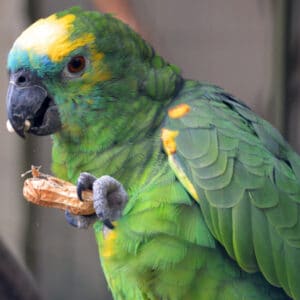Last Updated on by Mitch Rezman
Super Bowl Sunday and we’re pinned in by snow and freezing temperatures. Popcorn our blacktail Albino Cockatiel (A.k.a. the tail dragger) flitting between the top of my computer monitor play stand and the floor creating little clouds of seed husks and the pieces of woven IKEA baskets at the bottom of our entertainment center.
How do I pick what to write about each week? I’m an analog guy living in a digital world. Being a post-war baby boomer I grew up watching black-and-white TV. I still like watching old war movies where the radio guy is frantically turning dials trying to “tune in” to a certain radiofrequency.
You may be reading this from an email, on our blog, or perhaps from a link from a social media site. We have an 800 number. That puts me in front of a LOT of people. Asking for your feedback and listening to your bird care challenges, has fallen under the “be careful what you wish for column”. It’s getting kind of noisy here people – but in a good way. There is no app or software that truly allows you to “tune in” I try to get out there and chat with a lot of you – if’s the analog side of things. So I’ll usually pick a topic with the most “noise” at the time I’m sitting down to write.
A constant source of discussion is bird nutrition. The calls and the inquiries start many times with, “we want our birds to eat what they would eat in the wild so they can eat healthy!’ Which makes perfect sense, to provide the equivalent of what your bird would eat in the South American rain forest, Australian Outback or Serengeti plains in Africa.
How can I say this indelicately? I can’t – Are you freakin nuts? It’s not uncommon to see flocks of birds in the wild with a mortality rate of 20% or more. Did you know the largest threat to California Condors is lead poisoning from carcasses that hunters choose to abandon?
Seriously, this is the 21st-century, Which seems to be the century of “can we make things any more complicated?” Social media sites are filled with every bird companion’s opinion on proper nutritional programs for hundreds of parrot/bird and parakeet species. Lots of conflicting evangelists. What’s right for your bird? Quite frankly, I’m not sure, so over the next few weeks, I’m going to lay out all the nutritional options we offer. Then you can hopefully begin to decide, the path you seek to follow.
I will frame this by telling you that if your bird is getting good nutrition, don’t change what works. In that, we offer a huge variety of bird food and treats you may see things you haven’t before. Different doesn’t need to mean better. We just wanted to let you know there are solutions – even for “your” bird
We’ve been offering Hagen For about 10 years. Hagen bird foods are unique for a number of reasons. Notably, they use approximately 350 pairs of parrots both domestic and wild-caught to develop their brand. One notable statement Mark Hagen the developer of these foods makes is “Some Breeders have a romantic notion that captive diets which are complicated, labor-intensive, using expensive ingredients are the most nutritious. Yet it is possible to feed easy to prepare, cost-efficient diets which do not compromise proper levels of essential nutrients.”
Hagen has and continues to micro measure input as well as output, Hagen has been able to create a full line of avian nutrition is split into three brands. Living World, Tropimix & Tropican. Living World Premium Parrot Food contains assorted exotic nuts, naturally grown fruits and vegetables, plus Tropican Fruity Granules. It can be a good diet base when combined with the appropriate fresh foods.
Author Profile
Latest entries
 The Traveling BirdJune 26, 2025Can You Name 5 Parrot Species That Are Living Wild in the USA?
The Traveling BirdJune 26, 2025Can You Name 5 Parrot Species That Are Living Wild in the USA? Bird BehaviorJune 26, 2025How is it Parrots Are Problem Solvers Social Animals and Even Use Tools?
Bird BehaviorJune 26, 2025How is it Parrots Are Problem Solvers Social Animals and Even Use Tools? Bird & Parrot AnatomyJune 25, 2025How a Tiny Chemical Modification Makes Parrots Nature’s Living Paintings
Bird & Parrot AnatomyJune 25, 2025How a Tiny Chemical Modification Makes Parrots Nature’s Living Paintings PigeonsJune 20, 2025How Do Parrots Thrive in Cities Outside Their Native Habitats?
PigeonsJune 20, 2025How Do Parrots Thrive in Cities Outside Their Native Habitats?




